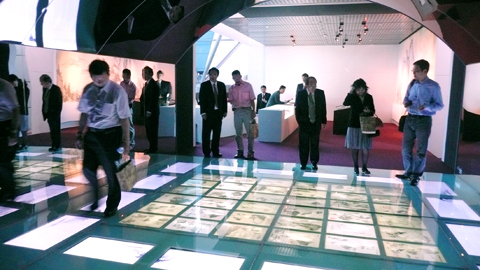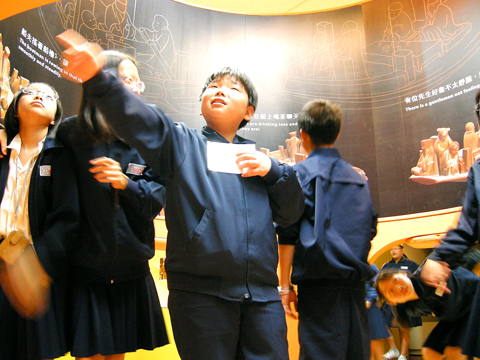Last week, the National Palace Museum opened two new exhibition spaces that are a marked departure from convention. One is the Museum of Tomorrow (未來博物館) located in the Departure Lounge at Terminal Two of the Taiwan Taoyuan International Airport, and the other is the Children’s Gallery (兒童學藝中心) located on the B1 level of the museum’s main building opposite the gift shop. Both are products of the strenuous efforts by director Lin Man-li (林曼麗) to bring the museum’s massive collection to a broader audience.
For decades, the National Palace Museum has been content with possessing one of the biggest and most valuable collections of Chinese art in the world. With such treasures to display, there seemed little need to do much more to ensure a steady stream of visitors. What was neglected was the local audience. At the opening of the Children’s Gallery last Thursday, educationalist Su Chen-ming (蘇振明) said that though 85 percent of all Taiwanese primary and secondary school students have visited the National Palace Museum, most, in his experience, remembered virtually nothing of what they had seen. Speaking of the challenges faced as one of a number of consultants brought in to advise the museum on creating an educational yet joyful environment in which children could become acquainted with its collection, he said it was important to find a new language of explanation and experience for children.
Aimed at children aged between 7 and 12, the Children’s Gallery has been nearly two years in the making. Lin said the idea of building bridges to make the National Palace Museum accessible to children had been one of her priorities ever since taking up her position as director. While little is startling innovative, there is certainly plenty of appeal, and school children who had been invited to the opening seemed to be having genuine fun working out some aspects of bridge construction using hard cushions and wooden rods, doing simple movable-type printing of well-known poems and looking at displays that draw connections between the activities depicted in famous paintings and daily activities of life today.

PHOTOS: COURTESY OF THE NPM
According to project manager Liu Chia-lun (劉家倫), a key point in the design of the gallery was to present aspects of the National Palace Museum’s permanent collection so that children could experience the same highlights that their parents did, though through a slightly different medium, and importantly for the “little friends” (小朋友), in display cases positioned for those around one meter in height. “In the museum the display cases are positioned for adults and the notes are intended for adults, and this is not readily accessible for kids. Here we have a more playful atmosphere but we can also show off some of the great works stored in the [museum]” Liu said. “Through technologies such as multimedia and animation, we can speak more directly to young children. This can also supplement those aspects of the display that cannot be adequately conveyed through conventional means,” she said
Another crucial aspect of the gallery is its team of more than 40 volunteers, some of them retired teachers, others members of the museum’s cadre of multilingual guides with an interest in working with children. Despite all the video screens and other high-tech gadgetry, a cursory look at the museum in action suggested their efforts more than anything else will determine the success or failure of this venture.
The museum’s other effort to diversify, which can be seen at Terminal Two of the Taiwan Taoyuan International Airport, takes a more conceptual approach, trying to marry it collection of classical antiquities with contemporary artistic ideas. Artists Yuan Goang-ming (袁廣鳴), Mei Dean-I (梅丁衍), Chen Chin-cheng (陳志誠) and Lin Tay-jou (林泰州), among many others, have been commissioned to create their own works based on items in the National Palace Museum’s collection, making use of the usual panoply of digital media. It seems unfortunate that this attempt by the museum to show it is keeping up with the times has been secreted beyond the immigration desk of the airport’s departure hall, and will therefore remain forever inaccessible to anyone not actually leaving Taiwan. And, given its location, how will it compete with the high-concept packaging and sales strategies of the alcohol and cosmetic merchants on display in the Duty Free outlets?

PHOTOS: COURTESY OF THE NPM
Museum notes:
What: Children’s Gallery (兒童學藝中心)
Where: National Palace Museum (國立故宮博物院), 221, Zhishan Rd Sec 2, Taipei City (台北市至善路二段221號)
Hours: 9am to noon; 1:30pm to 4:30pm
Tickets: Admission is free. Groups of more than 10 people must book seven days in advance. A maximum of 60 people are permitted in the gallery at any one time. Call (02) 2881-2021 X 2851 for bookings and additional information

Behind a car repair business on a nondescript Thai street are the cherished pets of a rising TikTok animal influencer: two lions and a 200-kilogram lion-tiger hybrid called “Big George.” Lion ownership is legal in Thailand, and Tharnuwarht Plengkemratch is an enthusiastic advocate, posting updates on his feline companions to nearly three million followers. “They’re playful and affectionate, just like dogs or cats,” he said from inside their cage complex at his home in the northern city of Chiang Mai. Thailand’s captive lion population has exploded in recent years, with nearly 500 registered in zoos, breeding farms, petting cafes and homes. Experts warn the

The unexpected collapse of the recall campaigns is being viewed through many lenses, most of them skewed and self-absorbed. The international media unsurprisingly focuses on what they perceive as the message that Taiwanese voters were sending in the failure of the mass recall, especially to China, the US and to friendly Western nations. This made some sense prior to early last month. One of the main arguments used by recall campaigners for recalling Chinese Nationalist Party (KMT) lawmakers was that they were too pro-China, and by extension not to be trusted with defending the nation. Also by extension, that argument could be

Aug. 4 to Aug. 10 When Coca-Cola finally pushed its way into Taiwan’s market in 1968, it allegedly vowed to wipe out its major domestic rival Hey Song within five years. But Hey Song, which began as a manual operation in a family cow shed in 1925, had proven its resilience, surviving numerous setbacks — including the loss of autonomy and nearly all its assets due to the Japanese colonial government’s wartime economic policy. By the 1960s, Hey Song had risen to the top of Taiwan’s beverage industry. This success was driven not only by president Chang Wen-chi’s

Last week, on the heels of the recall election that turned out so badly for Taiwan, came the news that US President Donald Trump had blocked the transit of President William Lai (賴清德) through the US on his way to Latin America. A few days later the international media reported that in June a scheduled visit by Minister of National Defense Wellington Koo (顧立雄) for high level meetings was canceled by the US after China’s President Xi Jinping (習近平) asked Trump to curb US engagement with Taiwan during a June phone call. The cancellation of Lai’s transit was a gaudy